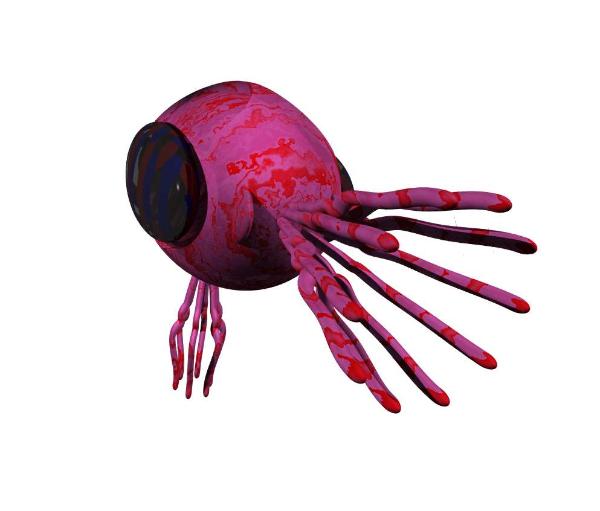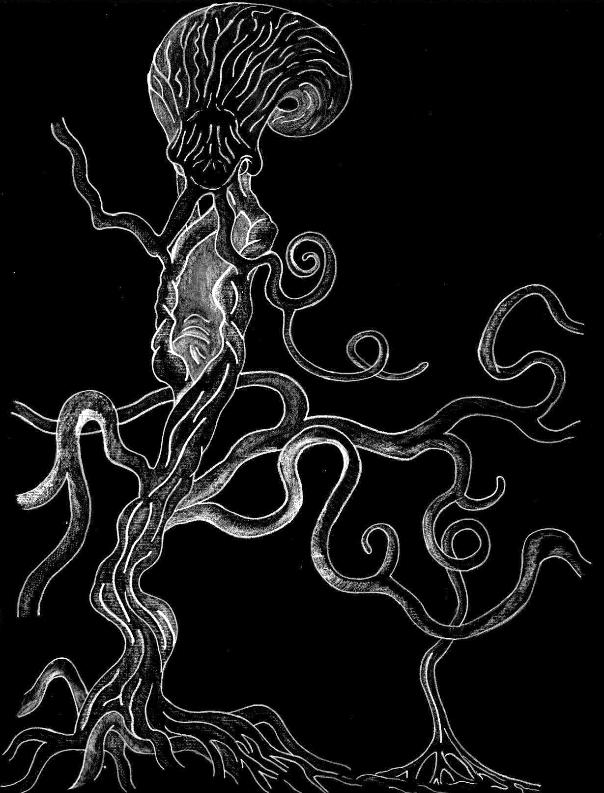| Nonoborachnids |
So-called because they have 9-10 manipulator tentacles, which function like arms. A set of smaller ventral
tentacles lies beneath the head-like body. Their anatomy is much reduced as they constitute little more than
tentacled heads with large brains and a rudimentary respiratory system (they have one pair of nostrils at the back
of the body). They do not function as independent creatures, but rather they genetically engineer and clone
organic bodies to suite their needs. These bodies resemble living creatures, often curious spider-like organisms
with no heads and only rudimentary central nervous systems. These creatures can not function without a
Nonoborachnid 'head'. The Nonoborachnid is placed upon its body of choice, into which the ventral tentacles slot.
These tentacles then synapse with the nervous system of the organic body and then the composite functions as a
single entity.
The Nonoborachnids communicate with a combination of skin pattern changes, as their skin can change its hue
very rapidly, creating a complex pattern display, and also high-pitched buzzing sounds produced by vibratory
organs within the pair of protuberant flaps either side of the anterior tentacles. The tentacles are able to perceive
these high-pitched sounds as they are extremely sensitive to vibration (as well as touch, humidity, smell and
taste). The pair of depressions above the eyes are thought to be pressure sensors. Their enormous eyes are
highly sensitive and they ordinarily avoid very bright lights.
Not a great deal is known about Nonoborachnid society and culture. What little contact they have had with other
races in the known galaxy has been unpredictable, as they vary from pacifist to aggressive territorialism
defending their own economic interests against other aliens.
They appear to derive their nourishment direct from their organic vehicles, which in turn take in nourishment
directly from processed biochemical soup. It has been suggested that the Nonoborachnids evolved from parasitic
mind-control organisms by selectively breeding their hosts. An alternative theory suggests that they developed
biotechnology upon which they became so dependent that their bodies degenerated. Yet a third theory has it that
these creatures evolved in an aquatic environment and utilised organic bodies to cope with terrestrial or high
gravity environments.
tentacles lies beneath the head-like body. Their anatomy is much reduced as they constitute little more than
tentacled heads with large brains and a rudimentary respiratory system (they have one pair of nostrils at the back
of the body). They do not function as independent creatures, but rather they genetically engineer and clone
organic bodies to suite their needs. These bodies resemble living creatures, often curious spider-like organisms
with no heads and only rudimentary central nervous systems. These creatures can not function without a
Nonoborachnid 'head'. The Nonoborachnid is placed upon its body of choice, into which the ventral tentacles slot.
These tentacles then synapse with the nervous system of the organic body and then the composite functions as a
single entity.
The Nonoborachnids communicate with a combination of skin pattern changes, as their skin can change its hue
very rapidly, creating a complex pattern display, and also high-pitched buzzing sounds produced by vibratory
organs within the pair of protuberant flaps either side of the anterior tentacles. The tentacles are able to perceive
these high-pitched sounds as they are extremely sensitive to vibration (as well as touch, humidity, smell and
taste). The pair of depressions above the eyes are thought to be pressure sensors. Their enormous eyes are
highly sensitive and they ordinarily avoid very bright lights.
Not a great deal is known about Nonoborachnid society and culture. What little contact they have had with other
races in the known galaxy has been unpredictable, as they vary from pacifist to aggressive territorialism
defending their own economic interests against other aliens.
They appear to derive their nourishment direct from their organic vehicles, which in turn take in nourishment
directly from processed biochemical soup. It has been suggested that the Nonoborachnids evolved from parasitic
mind-control organisms by selectively breeding their hosts. An alternative theory suggests that they developed
biotechnology upon which they became so dependent that their bodies degenerated. Yet a third theory has it that
these creatures evolved in an aquatic environment and utilised organic bodies to cope with terrestrial or high
gravity environments.
Above: A nonobarachnid mainframe interface nodule. These colonial cybernetically modified
Beneath the head (the quid-like thing) of each nodule is the interface booth in which a
nonoborachnid sits (the one above is empty). Once inside the nonoborachnid interfaces to the
nodule nervous system and takes command of its local brain. The nervous systems of all the
nodules are interconnected. The nervous systems of these computers are based on
supra-luminal velocity fibre optics.
Beneath the head (the quid-like thing) of each nodule is the interface booth in which a
nonoborachnid sits (the one above is empty). Once inside the nonoborachnid interfaces to the
nodule nervous system and takes command of its local brain. The nervous systems of all the
nodules are interconnected. The nervous systems of these computers are based on
supra-luminal velocity fibre optics.
The Nonoborachnid homeworld, Zanossos, was originally not much unlike the Earth, but it
soon became polluted and its ecosystems now largely consist of microbial sludge.
soon became polluted and its ecosystems now largely consist of microbial sludge.
Rear view
Front view
The Nonoborachnids are an ancient lineage which
colonised a vast region of space many centuries ago. Early
in their history one faction of Nonoborachnids devolved
from the parasitic mode of life and took to moving about on
their oral arms, which now number 16. The ventral
tentacles having reduced to 8 small papillae or altogether
absent. These are the Octoborachnids. This form dwells
primarily on the dim twilight world of T'mar Nexos. Their
large multifaceted eyes are well-adapted to detect even the
slightest movement in the dim light of their world. Some
scientists speculate that the Nonoborachnids who
colonised this world attempted to synapse with a host
species on the planet but the host counter-reacted and the
two organisms fused into a new species, forming the
Octoborachnids. Certainly, their genetic material contains
an additional plasmid element.
colonised a vast region of space many centuries ago. Early
in their history one faction of Nonoborachnids devolved
from the parasitic mode of life and took to moving about on
their oral arms, which now number 16. The ventral
tentacles having reduced to 8 small papillae or altogether
absent. These are the Octoborachnids. This form dwells
primarily on the dim twilight world of T'mar Nexos. Their
large multifaceted eyes are well-adapted to detect even the
slightest movement in the dim light of their world. Some
scientists speculate that the Nonoborachnids who
colonised this world attempted to synapse with a host
species on the planet but the host counter-reacted and the
two organisms fused into a new species, forming the
Octoborachnids. Certainly, their genetic material contains
an additional plasmid element.
T'mar Nexos. Photosynthetic aerial life-forms are the main primary producers of the T'mar
infrared radiation for photosynthesis.
infrared radiation for photosynthesis.






